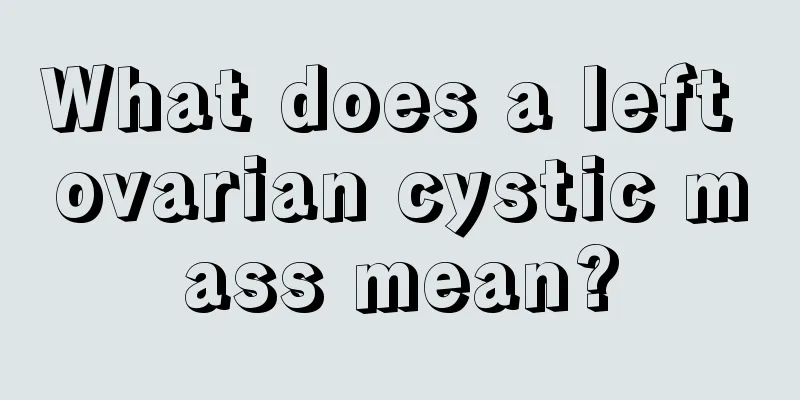What does a left ovarian cystic mass mean?

|
Left ovarian cystic mass is a relatively common ovarian phenomenon. This phenomenon can be either physiological or pathological. If the left ovarian cystic mass exceeds five centimeters, it is necessary to consider whether it is caused by an ovarian cyst. Below, we will introduce you to some relevant knowledge about ovarian cysts! 1. What does a left ovarian cystic mass mean? Most of the cystic masses in the ovaries are physiological and are developing follicles. They will change with the menstrual cycle. If they are larger than five centimeters, they are pathological cysts and require regular check-ups or surgical removal. Therefore, regular checks are needed. If it does not exceed five centimeters, no treatment is required. 2. Causes of ovarian cysts 1. Genetic factors According to statistics, 20% to 25% of ovarian tumor patients have a family history. 2. Endocrine factors The ovaries are important organs for ovulation and secretion of gonadal hormones. Ovarian tumors often occur during the reproductive age. Clinically, the basic pathophysiological change in many patients with ovarian cysts and polycystic ovary syndrome is that the ovaries produce too much androgen, and the excessive production of androgen is the result of the synergistic dysfunction of multiple endocrine systems in the body. 3. Lifestyle factors Long-term bad diet structure, living habits, and excessive psychological stress can lead to physiological ovarian cysts and true ovarian tumors. 4. Environmental factors Food contamination, such as plant growth hormones used in vegetables, and hormone ingredients such as clenbuterol in formula feeding of livestock and poultry. In recent years, with the improvement of living standards and changes in eating habits in my country, as well as the abuse of hormone drugs and tonics such as breast augmentation, weight loss, and anti-aging by some young and middle-aged women, the high incidence and younger age of ovarian tumors may also be related. 3. Clinical manifestations of ovarian cysts The most significant feature of an abdominal mass that is smaller than medium in size, if without complications or malignant transformation, is its mobility, which can often move from the pelvic cavity to the abdominal cavity. In malignant or inflammatory conditions, the tumor is restricted in movement, tenderness is present, and even symptoms of peritoneal irritation and ascites may occur. |
<<: What does a cystic mass in the right adnexal area mean?
>>: Why is my vulva itchy all the time?
Recommend
Here is everything you want to know about deafness and cochlear implants!
The sound of traffic on the street, the sound of ...
What are the methods of female private exercises?
In daily life, we often hear some male friends co...
Angong Niuhuang Pills, are you really using it correctly?
In the eyes of ordinary old people, Angong Niuhua...
What should I do if I have sex less than one month after the miscarriage?
Women who have undergone an abortion are very wea...
What to eat if you have kidney yin deficiency? 5 foods to help
Kidney deficiency is a very common symptom in lif...
What medicine is better for treating cervical erosion?
Cervical erosion is a disease that makes many wom...
How to prevent anisometropia?
Anisometropia refers to the difference in the ref...
What should asthma patients pay attention to in their home life?
Author: Huang Kewu, Chief Physician, Beijing Chao...
The difference between having a period and being pregnant
Menstruation is a physiological phenomenon that o...
Why are my nipples hard and painful? The gynecologist tells you
Some women will find that their nipples are relat...
What should I do if a woman sweats while sleeping at night?
Many women are troubled by sweating at night, bec...
How long does it take to insert the medicine after abortion?
Abortion is a method for women to terminate pregn...
Green urine in women
Normal urine is light yellow in color and does no...
Why can't I have abortion at 45?
The scope of application of medical abortion refe...
Is it poisonous to place pennywort in the room? Where is pennywort usually placed in the house?
The copper coin grass is very common in life. Bec...









